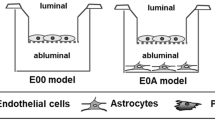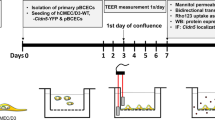Summary
Cocultures of human umbilical vein endothelial cells (ECV304) and rat glioma cells (C6) from two commercial sources, American Type Culture Collection and European Collection of Animal Cell Cultures, were evaluated as an in vitro model for the blood-brain barrier. Monolayers of endothelial cells grown in the presence or absence of glial cells were examined for transendothelial electrical resistance, sucrose permeability, morphology, multidrug resistance-associated protein expression, and P-glycoprotein expression and function. Coculture of glial cells with endothelial cells increased electrical resistance and decreased sucrose permeability across European endothelial cell monolayers, but had no effect on American endothelial cells. Coculture of European glial cells with endothelial cells caused cell flattening and decreased cell stacking with both European and American endothelial cells. No P-glycoprotein or multidrug resistance-associated protein was immunodetected in endothelial cells grown in glial cell-conditioned medium. Functional P-glycoprotein was demonstrated in American endothelial cells selected in vinblastine-containing medium over eight passages, but these cells did not form a tight endothelium. In conclusion, while European glial cells confer blood-brain barrier-like morphology and barrier integrity to European endothelial cells in coculture, the European endothelial-glial cell coculture model does not express P-glycoprotein, normally found at the blood-brain barrier. Further, the response of endothelial cells to glial factors was dependent on cell source, implying heterogeneity among cell populations. On the basis of these observations, the umbilical vein endothelial cell-glial cell coculture model does not appear to be a viable model for predicting blood-brain barrier penetration of drug molecules.
Similar content being viewed by others
References
Abbott, N. J.; Romero, I. A. Transporting therapeutics acorss the blood-brain barrier. Mol. Med. 106–113; 1996.
Adson, A.; Raub, T. J.; Burton, P. S.; Barsuhn, C. L.; Hilgers, A. R.; Audus, K. L.; Ho, N. F. H. Quantitative approaches to delineate paracellular diffusion in cultured epithelial cell monolayers. J. Pharm. Sci. 83:1529–1536; 1994.
Barrand, M. A.; Robertson, K. J.; von Weikersthal, S. F. Comparisons of P-glycoprotein expression in isolated rat brain microvessels and in primary cultures of endothelial cells derived from microvasculature of rat brain, epididymal fat pad and from aorta. FEBS Lett. 374:179–183; 1995.
Beck, W. T.; Cirtain, M. C.; Danks, M. K.; Felsted, R. L.; Safa, A. R.; Wolverton, J. S.; Suttle, D. P.; Trent, J. M. Pharmacological, molecular, and cytogenetic analysis of “atypical” multidrug-resistant human leukemic cells. Cancer Res. 47:5455–5460; 1987.
Beck, W. T.; Mueller, M. J.; Tanzer, L. R. Altered surface membrane glycoproteins in vinca alkaloid-resistant human leukemic lymphoblast. Cancer Res. 39:2070–2076; 1979.
Ceballos, G.; Rubio, R. Coculture of astroglial and vascular endothelial cells as apposing layers enhances the transcellular transport of hypoxanthine. J. Neurochem. 64:991–999; 1995.
Cole, S. P.; Sparks, K. E.; Fraser, K.; Loe, D. W.; Grant, C. E.; Wilson, G. M.; Deeley, R. G. Pharmacological characterization of multidrug resistant MRP-transfected human tumor cells. Cancer Res. 54:5902–5910; 1994.
Delie, F.; Rubas, W. A human colonic cell line sharing similarities with enterocytes as a model to examine oral absorption: advantages and limitations of the caco-2 model. Crit. Rev. Ther. Drug Carrier Syst. 14:221–286; 1997.
Eddy, E. P.; Maleef, B. E.; Hart, T. K.; Smith, P. L. In vitro models to predict blood-brain barrier permeability. Adv. Drug Deliv. Rev. 23:185–198; 1997.
Feller, N.; Broxterman, H. J.; Wahrer, D. C.; Pinedo, H. M. ATP-dependent efflux of calcein by the multidrug resistance protein (MRP): no inhibition by intracellular glutathione depletion. FEBS Lett. 368:385–388; 1995.
Gueiros-Filho, F. J.; Viola, J. P.; Gomes, F. C.; Farina, M.; Lins, U.; Bertho, A. L.; Wirth, D. F.; Lopes, U. G. Leishmania amazonensis: multidrug resistance in vinblastine-resistant promastigotes is associated with rhodamine 123 efflux, DNA amplification, and RNA overexpression of a leishmania mdrl gene. Exp. Parasitol. 81:480–490; 1995.
Hayat, M. A. Fixation for electron microscopy. New York: Academic Press; 1981.
Huai-Yun, H.; Secrest, D. T.; Mark, K. S.; Carney, D.; Brandquist, C.; Elmquist, W. F.; Miller, D. W. Expression of multidrug resistance-associated protein (MRP) in brain microvessel endothelial cells. Biochem. Biophys. Res. Commun. 243:861–820; 1998.
Hurst, R. D.; Fritz, I. B. Properties of an immortalized vascular endothelial/glioma cell co-culture model of the blood-brain barrier. J. Cell. Physiol. 167:81–88; 1996.
Jetté, L.; Têtu, B.; Béliveau, R. High levels of P-glycoprotein detected in isolated brain capillaries. Biochim. Biophys. Acta 1150:147–154; 1993.
Joly, B.; Fardel, O.; Cecchelli, R.; Chesne, C.; Puozzo, C.; Guillouzo, A. Selective drug transport and P-glycoprotein activity in an in vitro blood-brain barrier model. Toxicol. In Vitro 9:357–364; 1995.
Kusuhara, H.; Suzuki, H.; Naito, M.; Tsuruo, T.; Sugiyama, Y. Characterization of efflux transport of organic anions in a mouse brain capillary endothelial cell line. J. Pharmacol. Exp. Ther. 285:1260–1265; 1998.
Laemmli, U. K. Cleavage of structural proteins during the assembly of the head of bacteriophage T4. Nature (London) 227:680–685; 1970.
Leppert, P. S.; Fix, J. A. Increased expression of P-glycoprotein-like effluxcarrier in drug-resistant caco-2 cells. Pharm. Res. 12:S294; 1995.
Morgan, D. J. Drug disposition in mother and foetus. Clin. Exp. Pharmacol. Physiol. 24:869–873; 1997.
Onishi, T.; Tamai, I.; Sakanaka, K.; Sakata, A.; Yamashima, T.; Yamashita, J.; Tsuji, A. In vivo and in vitro evidence for ATP-dependency of P-glycoprotein-mediated efflux of doxorubicin at the blood-brain barrier. Biochem. Pharmacol. 49:1541–1544; 1995.
Pardridge, W. M. Blood-brain barrier carrier-mediated transport and brain metabolism of amino acids. Neurochem. Res. 23:635–644; 1998a.
Pardridge, W. M. CNS drug design based on principles of blood-brain barrier transport. J. Neurochem. 70:1781–1792; 1998b.
Regina, A.; Koman, A.; Piciotti, M.; Hafny, B. E.; Center, M. S.; Bergmann, R.; Couraud, P.-O.; Roux, F. Mrp1 multidrug resistance-associated protein and P-glycoprotein expression in rat brain microvessel endothelial cells. J. Neurochem. 71:705–715; 1998.
Reinhardt, C. A.; Gloor, S. M. Co-culture blood-brain barrier models and their use for pharmatoxicological screening. Toxicol. In Vitro 11:513–518; 1997.
Rubin, L. L.; Hall, D. E.; Porter, S.; Barbu, K.; Cannon, C.; Horner, H. C.; Janatpour, M.; Liaw, C. W.; Manning, K.; Morales, J.; Tanner, L. I.; Tomaselli, K. J.; Bard, F. A cell culture model of the blood-brain barrier. J. Cell Biol. 115:1725–1735; 1991.
Sakata, A.; Tamai, I.; Kawazu, K.; Deguchi, Y.; Ohnishi, T.; Saheki, A.; Tsuji, A. In vivo evidence for ATP-dependent and P-glycoprotein-mediated transport of cyclosporin A at the blood-brain barrier. Biochem. Pharmacol. 48:1989–1992; 1994.
Seetharaman, S.; Barrand, M. A.; Maskell, L.; Scheper, R. Multidrug resistance-related transport proteins in isolated human brain microvessels and in cells cultured from these isolates. J. Neurochem. 70:1151–1159; 1998.
Shivers, R. R.; Arthur, F. E.; Bowman, P. D. Induction of gap junctions and brain endothelium-like tight junctions in cultured bovine endothelial cells: local control of cell specialization. J. Submicrosc. Cytol. Pathol. 20:1–14; 1988.
Sikic, B. I.; Fisher, G. A.; Lum, B. L.; Halsey, J.; Beketic-Oreskovic, L.; Chen, G. Modulation and prevention of multidrug resistance by inhibitors of P-glycoprotein. Cancer Chemother. Pharmacol. 40 Suppl:S13-S19; 1997.
Takahashi, K.; Sawasaki, Y.; Hata, J.; Mukai, K.; Goto, T. Spontaneous transformation and immortalization of human endothelial cells. In Vitro Cell. Dev. Biol. 26:265–274; 1990.
Tiberghien, F.; Loor, F. Ranking of p-glycoprotein substrates and inhibitors by a calcein-AM fluorometry screening assay. Anticancer Drugs 7:568–578; 1996.
Tio, S.; Deenen, M.; Marani, E. Astrocyte-mediated induction of alkaline phosphatase activity in human umbilical cord vein endothelium: an in vitro model. Eur. J. Morphol. 28:289–300; 1990.
Tishler, D. M.; Weinberg, K. I.; Hinton, D. R.; Barbaro, N.; Annett, G. M.; Raffel, C. MDR1 gene expression in brain of patients with medically intractable epilepsy. Epilepsia 36:1–6; 1995.
Tsuji, A.; Tamai, I. Blood-brain barrier function of p-glycoprotein. Adv. Drug Deliv. Rev. 25:287–298; 1997.
Wang, Q.; Yang, H.; Miller, D. W.; Elquist, W. F. Effect of the P-glycoprotein inhibitor, cyclosporin A, on the distribution of rhodamine-123 to the brain: an in vivo microdialysis study in freely moving rats. Biochem. Biophys. Res. Commun. 211:719–726; 1995.
Wigler, P. W. Cellular drug efflux and reversal therapy of cancer. J. Bioenerg. Biomembr. 28:279–284; 1996.
Author information
Authors and Affiliations
Rights and permissions
About this article
Cite this article
Scism, J.L., Laska, D.A., Horn, J.W. et al. Evaluation of an in vitro coculture model for the blood-brain barrier: Comparison of human umbilical vein endothelial cells (ECV304) and rat glioma cells (C6) from two commercial sources. In Vitro Cell.Dev.Biol.-Animal 35, 580–592 (1999). https://doi.org/10.1007/s11626-999-0096-3
Received:
Accepted:
Issue Date:
DOI: https://doi.org/10.1007/s11626-999-0096-3




